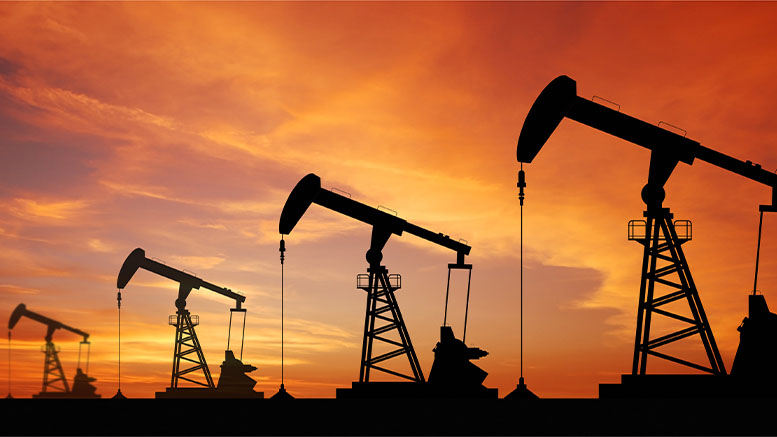By Nicole Pollack
Casper Star-Tribune
Via- Wyoming News Exchange
CASPER — As Russia lays siege to its neighbor, the West has rallied behind Ukraine, wielding dollars, euros and pounds against the 11th-biggest economy in the world. The European Union, reliant on Russian fossil fuels but loath to let Vladimir Putin’s government weaponize its exports, took economic aim at Russia’s oil tankers and gas pipelines, and cut itself off before its opponents could.
The sanctions are working: Russia, now isolated from the global financial system, has already struggled to sell oil and coal. But putting that kind of pressure on a top-three oil exporter — the biggest supplier of fossil fuels to Europe — comes at a global cost.
Especially in the energy sector.
In Europe, natural gas prices are breaking records, even as Russian imports continue to arrive. Crude oil prices surged to a 10-year high worldwide. U.S. gasoline prices are climbing. Economists warn that Americans will face steep energy costs until the war ends. Maybe — some say probably — even steeper than today.
For Wyoming, perhaps more than any other state, a war being fought on the other side of the world could have far-reaching implications.
Fossil fuels have been the lifeblood of Wyoming for decades. The state gets away with having low property taxes and no individual or corporate income tax by levying taxes on industries, particularly extractive ones.
The Wyoming economy expands and contracts along with the oil and gas markets. It’s one of the most volatile state economies in the country.
Even before Russia caused prices to skyrocket, oil — which has replaced more economically stable coal as Wyoming’s biggest source of severance tax revenue — was forecast to experience a strong year.
Record low prices early in the pandemic caused production to plummet. Since then, demand has recovered, but production hasn’t, increasing prices.
The state agencies that predicted higher-than-expected oil prices in October, then revised that estimate up again in January, offered a rosy prognosis for state revenues in 2022. Since then, oil prices have surged ever higher.
“Clearly, there was not a regional conflict between Russia and Ukraine priced into that, nor should there be,” said Rob Godby, an economics professor at the University of Wyoming and one of the authors of the quarterly revenue report. “But it’s having real effects on our state revenues. And the longer this goes on, the greater that effect will be.”
Oil is traded globally. If its price changes in one market, other markets typically follow.
That’s why, as supply risks pushed prices up in Europe, U.S. benchmark West Texas Intermediate also went up. Higher oil prices generate more revenue for producers — and, as a result, for the state, which puts some severance tax money into savings and spends the rest on government operations and public services.
Before the pandemic, oil companies responded predictably to shifts in the market. When oil prices were low, production decreased, and prices rose. When prices were high, production increased, and prices fell.
Now, despite high oil prices that persisted for months before the invasion, companies have been slow to ramp up. Why that is depends on who you ask.
The oil industry says it’s because of uncertainty. To companies shaken by the last two years, new investments seem too risky. They’re afraid more lockdowns will again suppress demand and worried the Biden administration, which has yet to hold an onshore lease sale, will make it harder to secure leases or permit wells.
Some, particularly environmental groups, disagree.
They say oil companies are intentionally suppressing fuel production, then blaming the high prices on the Biden administration.
No one, even industry, can be sure how high prices could get before oil companies ramp up.
The U.S. government can’t force them. International oil cartel OPEC Plus has declined to significantly increase production to ease costs.
Experts warn that as the conflict drags on, Russia will likely find ways around the sanctions; as long as prices are up, any oil that it manages to sell will be that much more profitable.
A coordinated release of 60 million barrels of crude oil, about two-thirds of the volume consumed globally each day, from countries’ strategic petroleum reserves was announced Tuesday by the U.S. and 30 allies.
Though the move has been cheered as a show of international unity, it isn’t expected to have a lasting effect on prices. Risk tolerance varies considerably across U.S. companies and regions.
In Wyoming, where production is particularly costly and the high proportion of federal leases often prolongs the permitting process, companies tend to move more slowly.
“How that plays out is going to be a company-by-company decision,” said Gabriel Collins, a fellow at Rice University’s Baker Institute for Public Policy. “I think it’s going to come down to an operator-level decision of, basically, how quickly do you grab at the potential cash generation opportunity presented by higher commodity prices?”
For Wyoming, that means gasoline prices will probably keep ticking upward.
It could also stave off the ramifications of the state’s several-hundred-million-dollar budget deficit, patched in the near term with federal COVID-19 relief money, for a few more years.
In Europe, the natural gas price trendline looks a lot like oil’s swing: Since Russia invaded on Feb. 24, it’s gone up. And up. And up.
But U.S. prices haven’t really changed over the last couple of weeks. That’s because natural gas markets are more localized, insulating most regions from external supply shocks. At least for a while.
The U.S. in December became the world’s No. 1 exporter of liquefied natural gas (LNG). Those shipments, however, are near capacity.
Plans for some new LNG export infrastructure are already underway. Building even more will take money — and time. Companies hesitant to drill new wells may prove even more reluctant to sink money into a volatile international gas market.
According to Ana Maria Jaller-Markarewicz, a European energy analyst at the Institute for Energy Economics and Financial Analysis research group, if U.S. natural gas producers can access the European market, they’ll probably choose to.
“U.S. LNG exporters will prefer to sell to Europe at a higher price than sell gas in the U.S. This could create a reduction of gas supply in the U.S. which would then increase the price domestically,” Jaller-Markarewicz said in an emailed statement.
Notably, by the time the necessary infrastructure is in place, producers will have had plenty of time to permit and drill new wells. The impact of additional exports on supply could be lessened by an increase in domestic natural gas production.
“Suppliers could come into the market to take advantage of that — that would be their natural tendency,” Godby said. “That would then moderate the increase, because the demand would be met with more supply. The only question is whether suppliers will do that.”
U.S. natural gas prices are already elevated. Since June, the Henry Hub spot price has remained higher, and more volatile, than the prices seen over the last several years, pushing up heating costs for most Wyoming households.
Until a few weeks ago, the cost of natural gas was expected to settle over the next couple of years. Now economists suspect it will instead hold steady, or even go up, during that time.
Persistently high prices would mean more expensive winters for Wyoming homeowners. The state, meanwhile, could stand to profit.
Natural gas ranks second, after oil but ahead of coal, as a source of severance tax revenue in Wyoming. Like oil, it was forecast to have a lucrative year, and may also outperform predictions.
Natural gas is usually cheaper than coal. At a certain price, coal becomes competitive, and utilities that have both coal- and gas-fired power plants may start burning more coal. Many utilities, facing abnormally high natural gas prices, have done just that, driving up the price of Wyoming coal and temporarily reversing the industry’s decade-long decline.
“Higher natural gas prices are always good for coal,” said Travis Deti, executive director of the Wyoming Mining Association.
The spot price of coal mined in the Powder River Basin hovered between $8.25 and $13.25 per ton for a decade. In November, as utilities scrambled to secure coal for the winter, the spot price passed $30. It stayed that high for weeks.
Wyoming, the country’s biggest coal state, saw an uptick in hiring and a bump in production as demand went up, but its coal industry is unlikely to expand much more than that. Utilities aren’t building new coal plants. Coal companies aren’t opening new mines. After a while, the spot price started to subside.
As of Feb. 25, Powder River Basin coal cost $21.65 per ton. It was — and is — a temporary reprieve. Coal demand will almost certainly subside when natural gas prices stabilize.
The longer that takes, the better coal will fare. And if gas prices do go up, “it’s definitely going to prolong the use of Wyoming coal,” said Anne Alexander, an economics lecturer at the University of Wyoming.
Most Powder River Basin coal contracts are now sold out through 2023. Future demand will hinge on how utilities expect gas prices to change in the years that follow.
Renewables produce cheaper electricity than burning coal. Before last summer, natural gas usually did, too. Both of those sources also emit far less carbon than coal.
With price competition and climate concerns edging coal out of the market, the fuel now has a bigger infrastructure problem than its competitors.
Utilities aren’t just burning less of it. They’re closing their coal plants. Some utilities no longer have the option to fuel-switch. And after a lull last year, 6% of the country’s coal capacity is set to retire by the end of 2022.
Still, for the coal industry and the state, the relief could last longer than expected.
A little over a decade ago, about 70% of Wyoming’s revenue came from the mineral sector. Today, minerals contribute about half.
The drop is partly attributable to natural gas, but it’s mostly lost coal revenue, which has left Wyoming more vulnerable than ever to the booms and busts of the oil and gas industry. At current production levels, the industry can’t bridge that gap, but it, too, might pay more in severance taxes than it has in years.
Europe has known for a long time that getting roughly one-quarter of its oil and close to half of its natural gas from Russia was a risk. It hoped the alliance wouldn’t fray. The move worked for a while, but left Russia with a lot of influence over Europe.
To cut that off, Godby said, Europe will have to stop depending on Russia.
Executives from the American Petroleum Institute (API), the biggest U.S. oil and gas trade group, outlined their vision for the future of European energy during a call with reporters on Thursday.
“The only long-term solution is growing America’s energy leadership,” said Frank Macchiarola, API vice president of policy, economics and regulatory affairs.
The trade group called on the federal government to speed up permitting for LNG export infrastructure and promptly start holding quarterly oil and gas lease sales. The conflict in Ukraine shows that the world needs more energy, especially natural gas, the executives said. They believe the U.S. should supply it.
A statement issued Friday by 25 Republican governors, including Wyoming Gov. Mark Gordon, urged similar actions in addition to completion of the Keystone XL oil pipeline, which President Joe Biden canceled last year.
“The answer to the question of Russian oil is more American oil,” Sen. John Barrasso, R-WY, said to the state House of Representatives on Friday. “We are much better, safer and freer as a nation if we’re selling American energy to our friends than having to buy it from our enemies.”
API and other oil and gas advocates have appealed repeatedly to the federal government since the invasion, angering environmental groups, which say more U.S. drilling won’t solve European energy problems, and have accused the oil and gas industry of trying to exploit the conflict for profit.
The Biden administration has not indicated that it plans to change course.
Just about everyone agrees that in the coming months, Europe will need oil and gas. If it doesn’t come from Russia, it’ll have to be imported, at a higher cost, from elsewhere.
But Seth Feaster, a data analyst at the Institute for Energy Economics and Financial Analysis, doesn’t think Wyoming’s economic boost will last.
“Longer-term, high energy prices for coal, oil, and gas will increase the drive to build wind and solar, because they do not face any of the volatility in fuel costs, unlike fossil fuels,” Feaster said in an emailed statement.
Such a shift could already be happening.
A week after announcing that it would halt construction of a major Russian natural gas pipeline, Germany now appears poised to swear off of fossil fuels.
Europe’s biggest economy — and biggest consumer of Russian gas — intends to shift to 100% renewable electricity by 2035, Reuters reported Monday.
The consequences for Wyoming depend, most immediately, on what Russia does. It will be up to U.S. producers to respond. And then Europe will decide where to go from here.







